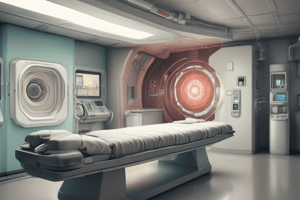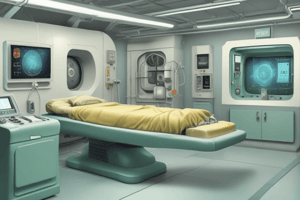Podcast
Questions and Answers
What is the main purpose of the Geiger-Muller (G-M) tube's quenching process?
What is the main purpose of the Geiger-Muller (G-M) tube's quenching process?
- To distinguish between types of radiation
- To increase the ionization of gas molecules
- To prevent continuous detection of radiation events (correct)
- To amplify the detected current
What initiates the avalanche of ionization in a Geiger-Muller tube?
What initiates the avalanche of ionization in a Geiger-Muller tube?
- The ionization of gas molecules by alpha, beta, or gamma radiation (correct)
- The emission of visible light from the scintillator
- The absorption of radiation by the photocathode
- The acceleration of positive ions towards the cathode
In scintillation counters, which component detects and amplifies the flashes of light?
In scintillation counters, which component detects and amplifies the flashes of light?
- Geiger-Muller tube
- Ionization chamber
- Photomultiplier tube (PMT) (correct)
- Scintillator crystal
What characteristic of the scintillation flash is used to determine the original photon energy?
What characteristic of the scintillation flash is used to determine the original photon energy?
Why is it important that the Geiger-Muller tube does not distinguish between different types of radiation?
Why is it important that the Geiger-Muller tube does not distinguish between different types of radiation?
What is one main purpose of film badges in radiation detection?
What is one main purpose of film badges in radiation detection?
What is the typical range for the 'Dead Time' of a Geiger-Muller tube?
What is the typical range for the 'Dead Time' of a Geiger-Muller tube?
What type of material serves as a scintillator in scintillation counters?
What type of material serves as a scintillator in scintillation counters?
What distinguishes thermoluminescence detectors (TLDs) from film badges?
What distinguishes thermoluminescence detectors (TLDs) from film badges?
What is a notable feature of a Geiger-Muller (GM) tube used for detecting radiation?
What is a notable feature of a Geiger-Muller (GM) tube used for detecting radiation?
How does the ionization process in the Geiger-Muller tube begin?
How does the ionization process in the Geiger-Muller tube begin?
What is the role of filters in a film badge?
What is the role of filters in a film badge?
Why are common radiation detectors based on detecting ionization?
Why are common radiation detectors based on detecting ionization?
Which of the following describes the function of scintillation counters?
Which of the following describes the function of scintillation counters?
What is a key characteristic of an ideal radiopharmaceutical for radio-imaging?
What is a key characteristic of an ideal radiopharmaceutical for radio-imaging?
How do coincident gamma photons contribute to PET imaging?
How do coincident gamma photons contribute to PET imaging?
What is measured during the 24-hour Thyroid Uptake Test?
What is measured during the 24-hour Thyroid Uptake Test?
Which of the following best describes a positron?
Which of the following best describes a positron?
What is the primary purpose of the Positron Emission Tomography (PET) imaging technique?
What is the primary purpose of the Positron Emission Tomography (PET) imaging technique?
Which event occurs when a positron encounters an electron?
Which event occurs when a positron encounters an electron?
How many gamma rays are produced during the annihilation of a positron and an electron?
How many gamma rays are produced during the annihilation of a positron and an electron?
What key feature allows for the localization of the source of gamma rays in PET?
What key feature allows for the localization of the source of gamma rays in PET?
In which orientation do the two gamma rays travel after positron-electron annihilation?
In which orientation do the two gamma rays travel after positron-electron annihilation?
What limitation is noted for older PET systems compared to CT?
What limitation is noted for older PET systems compared to CT?
What role does the first dynode play in a scintillation counter?
What role does the first dynode play in a scintillation counter?
Why is a collimator used in a gamma camera?
Why is a collimator used in a gamma camera?
How do scintillation counters indicate the detection of a photon?
How do scintillation counters indicate the detection of a photon?
What is the purpose of having multiple dynodes in a photomultiplier tube?
What is the purpose of having multiple dynodes in a photomultiplier tube?
What material is typically used for the crystal in a gamma camera?
What material is typically used for the crystal in a gamma camera?
What is the primary function of photomultiplier tubes in scintillation counters?
What is the primary function of photomultiplier tubes in scintillation counters?
What characteristic of the dynodes affects the detection efficiency of a scintillation counter?
What characteristic of the dynodes affects the detection efficiency of a scintillation counter?
How is spatial discrimination achieved in gamma cameras?
How is spatial discrimination achieved in gamma cameras?
What is the main type of radiation used in PET scans?
What is the main type of radiation used in PET scans?
Which imaging technique primarily provides structural tissue information?
Which imaging technique primarily provides structural tissue information?
What is a key difference between PET scans and CT scans regarding radiation sources?
What is a key difference between PET scans and CT scans regarding radiation sources?
Which feature is characteristic of CT imaging but not of PET imaging?
Which feature is characteristic of CT imaging but not of PET imaging?
How does the scan time of PET compare to CT imaging?
How does the scan time of PET compare to CT imaging?
What is the primary purpose of the radioactive tracer used in PET imaging?
What is the primary purpose of the radioactive tracer used in PET imaging?
Which of the following is NOT a characteristic of isotopes commonly used in PET imaging?
Which of the following is NOT a characteristic of isotopes commonly used in PET imaging?
How is fluorodeoxyglucose (FDG) typically utilized in PET imaging?
How is fluorodeoxyglucose (FDG) typically utilized in PET imaging?
What advantage does the integration of PET and CT provide?
What advantage does the integration of PET and CT provide?
What happens during the waiting period after injecting the radioactive tracer?
What happens during the waiting period after injecting the radioactive tracer?
Why are many PET radionuclides made on-site using a cyclotron?
Why are many PET radionuclides made on-site using a cyclotron?
Which of the following radiotracers is commonly used in PET scans?
Which of the following radiotracers is commonly used in PET scans?
What is the significance of 'co-registering' images from PET and CT scans?
What is the significance of 'co-registering' images from PET and CT scans?
Flashcards
Radioactive measurement techniques
Radioactive measurement techniques
Methods used to detect and measure radioactive materials.
Film Badge
Film Badge
A simple radiation detector that uses photographic film to indicate cumulative radiation exposure.
Geiger-Muller (GM) Tube
Geiger-Muller (GM) Tube
A radiation detector that measures ionization caused by radiation.
Radiation workers
Radiation workers
Signup and view all the flashcards
Absorbing filters
Absorbing filters
Signup and view all the flashcards
Radiation detectors
Radiation detectors
Signup and view all the flashcards
Scintillation counters
Scintillation counters
Signup and view all the flashcards
Gamma camera
Gamma camera
Signup and view all the flashcards
Geiger-Muller Tube
Geiger-Muller Tube
Signup and view all the flashcards
Ionization Avalanche
Ionization Avalanche
Signup and view all the flashcards
Dead Time (GM tube)
Dead Time (GM tube)
Signup and view all the flashcards
Quenching
Quenching
Signup and view all the flashcards
Scintillation
Scintillation
Signup and view all the flashcards
Scintillator
Scintillator
Signup and view all the flashcards
Photomultiplier Tube (PMT)
Photomultiplier Tube (PMT)
Signup and view all the flashcards
Dynode Chain
Dynode Chain
Signup and view all the flashcards
Sodium Iodide Crystal
Sodium Iodide Crystal
Signup and view all the flashcards
Collimator
Collimator
Signup and view all the flashcards
Position Logic Circuits
Position Logic Circuits
Signup and view all the flashcards
Spatial Discrimination
Spatial Discrimination
Signup and view all the flashcards
24-hour Thyroid Uptake Test
24-hour Thyroid Uptake Test
Signup and view all the flashcards
Radioactive Iodine Uptake (123I)
Radioactive Iodine Uptake (123I)
Signup and view all the flashcards
Overactive Thyroid
Overactive Thyroid
Signup and view all the flashcards
Underactive Thyroid
Underactive Thyroid
Signup and view all the flashcards
Positron Emission Tomography (PET)
Positron Emission Tomography (PET)
Signup and view all the flashcards
Positron-Electron Annihilation
Positron-Electron Annihilation
Signup and view all the flashcards
Coincidence Detection (PET)
Coincidence Detection (PET)
Signup and view all the flashcards
511 keV gamma rays
511 keV gamma rays
Signup and view all the flashcards
PET Scan
PET Scan
Signup and view all the flashcards
Co-registered Images
Co-registered Images
Signup and view all the flashcards
PET vs. CT vs. MRI
PET vs. CT vs. MRI
Signup and view all the flashcards
What makes PET unique?
What makes PET unique?
Signup and view all the flashcards
Coincident Gamma Photons
Coincident Gamma Photons
Signup and view all the flashcards
PET Imaging
PET Imaging
Signup and view all the flashcards
Positron Emission
Positron Emission
Signup and view all the flashcards
What are PET tracers made of?
What are PET tracers made of?
Signup and view all the flashcards
How are PET tracers introduced?
How are PET tracers introduced?
Signup and view all the flashcards
PET-CT
PET-CT
Signup and view all the flashcards
Co-registration in PET-CT
Co-registration in PET-CT
Signup and view all the flashcards
What does PET Imaging reveal?
What does PET Imaging reveal?
Signup and view all the flashcards
Why is Fluorodeoxyglucose (FDG) used in PET scans?
Why is Fluorodeoxyglucose (FDG) used in PET scans?
Signup and view all the flashcards
Study Notes
Gamma Camera & Positron Emission Tomography (PET)
-
Gamma cameras and PET are used in nuclear medicine imaging.
-
Radioactive measurement techniques are required for these methods.
-
Film badges, Geiger counters, and photomultiplier tubes are used to detect radiation.
-
Gamma cameras use a crystal to detect and measure gamma rays emitted from a radioactive substance within the body.
-
A gamma camera's structure involves a large flat crystal of sodium iodide with thousands of adjacent holes drilled through it for spatial discrimination of photon sources.
-
Photomultiplier tubes (PMTs) convert light into electronic signals to magnify the signal.
-
The position logic circuits immediately follow the PMT array and receive electrical impulses to identify the location of the scintillation event in the crystal.
-
Nuclear medicine uses radiopharmaceuticals, ideal radiopharmaceuticals have short half-lives, emit gamma rays with a low energy, and are non-toxic.
-
The thyroid 24-hour uptake test measures how much radioactive iodine the thyroid gland absorbs over 24 hours.
-
Positron emission tomography (PET) uses the annihilation of positrons and electrons to detect gamma rays in coincidence.
-
PET creates 3-D images of the distribution of a radiolabeled drug in the body.
-
Positrons are produced through several processes (e.g., pair production).
-
Positron annihilation creates two identical 511 keV gamma rays traveling in opposite directions.
-
The key to PET is detecting these coinciding gamma rays.
-
Newer PET systems use time-of-flight to precisely determine the location of gamma rays and thus improve image quality.
-
PET, combined with CT imaging, provides detailed anatomical information with metabolic information of the body.
-
Commonly used PET radionuclides include 11C, 13N, 15O, and 18F.
-
Radiotracers (e.g., fluorodeoxyglucose (FDG)) are widely used for metabolic activity studies.
Learning Outcomes
- Understand the requirement for radioactive measurement techniques.
- Understand how film badges, Geiger counters, and photomultiplier tubes are used to measure radiation.
- Describe the structure and function of gamma cameras and their use in nuclear imaging.
- Describe the properties of an ideal radiopharmaceutical for imaging.
- Describe the thyroid 24-hour uptake test.
- Discuss the principles of positron emission tomography (PET).
- Define and explain the use of coincident gamma photons and coincident lines in PET imaging.
- Describe the basic instrumentation of PET.
Studying That Suits You
Use AI to generate personalized quizzes and flashcards to suit your learning preferences.




